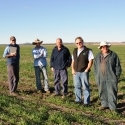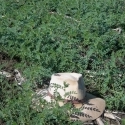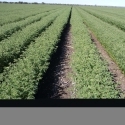30 Jun 2012
Gindee site - 2011/12 sorghum results
Managing K in northern cropping systems

Gindee Site, Sorghum results, 2011-2012
This site was sown to sorghum which was also harvested in May, with the trial exploring the interactions between P, K and S addition in a site in which all three nutrients were considered low. The soil is also a much heavier clay (CEC ~50 cmol/kg) than the Brookstead and Warra sites in southern Qld, which have a CEC ~ 25 cmol/kg, and is one in which there is considerable uncertainty about the appropriate K application strategy (both rate and placement) to overcome a high K buffer capacity and get K into the plant.
The site received good summer rainfall and was adequately supplied with N, but the crop growth was poor. Part of that was due to the low (but uniform) established plant population of only 24000 plants/ha (a risk mitigation strategy adopted by the grower to cope with variable in-season rainfall). However, growth was still disappointing.
Table 1. Biomass and grain yield responses in summer sorghum grown at Bendee, in the Gindie district south of Emerald.
Biomass | Grain | |
Kg/ha | ||
Control | 5372 | 2840 |
K | 6428 | 2720 |
P | 6670 | 3090 |
S | 5867 | 3110 |
PK | 6935 | 3200 |
PS | 7442 | 3440 |
KS | 6488 | 2840 |
PKS | 7035 | 3480 |
Biomass responses were recorded to P and K (20-25%), and there were indications of additive effects of P and S (38% greater than control), but not a combined PKS benefit. Grain yield again showed 8-10% yield responses to P or S, a combined PS effect representing a 21% increase but no additive effect when K was added to the P and S. This lack of a K response is again confusing, as soil tests showed this to be the lowest K site of any in the program. Exchangeable K in the 10-30cm layer was only 0.08 cmol/kg and TB-K tests suggested there were no detectable slow release K reserves. At this stage the biomass samples have been sent for analysis but we have not received results to determine whether the fertilizer K was accessed by the crop.
Sorghum was planted at the site but drought and then floods meant the site was abandoned. It will be sown to wheat in 2013.



